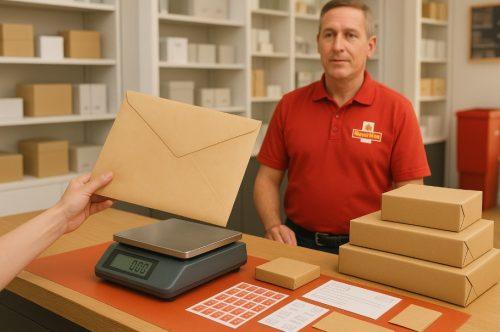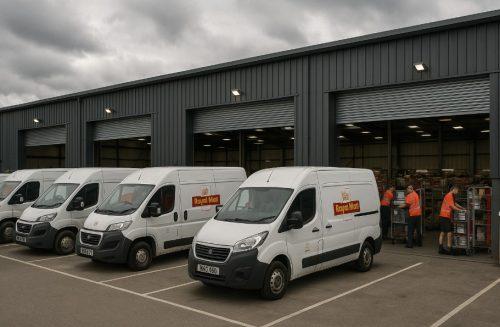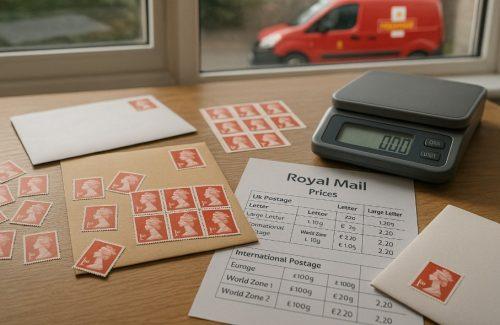|
Getting your Trinity Audio player ready...
|
Are you wondering how much a 1st class stamp will cost you in 2025? If so, you’re not alone. With postal charges frequently rising, many people across the UK are eager to understand how this affects their everyday mailing habits.
Royal Mail has announced several changes to its pricing in recent years, and 2025 is no exception. Whether you’re sending a birthday card or important business mail, knowing the exact cost helps you plan more effectively and avoid surprises at the Post Office.
Royal Mail continues to operate under its Universal Service Obligation, delivering letters six days a week, but rising operational costs and falling mail volumes have led to consistent price hikes.
With these shifts, staying informed about the most current stamp prices becomes essential for anyone who still relies on traditional mail.
In this guide, you’ll find everything you need to know about the current 1st class stamp price, reasons for the increase, and tips to save.
What is the Current 1st Class Stamp Price in the UK?

The current price of a Royal Mail 1st class stamp is £1.70. This applies to a standard letter weighing up to 100g and is the result of a recent price increase implemented by Royal Mail in response to rising operational costs and a significant decline in letter volumes.
Breakdown of key facts:
- Current Price: £1.70 per 1st class standard letter
- Previous Price: £1.65
- Price Difference: 5p increase
1st class stamps are commonly used for letters and documents that require faster delivery, with most items arriving the next working day. Despite ongoing price rises, the service remains a preferred choice for individuals and businesses due to its speed and reliability.
Royal Mail explains that higher delivery costs across a growing number of UK addresses make these price adjustments necessary. The Universal Service Obligation ensures consistent nationwide coverage, and stamp prices reflect the cost of maintaining that commitment.
In addition to the standard 1st class stamp, Royal Mail offers a range of related postage options based on item size, quantity, and usage needs.
Here is a detailed breakdown of the current 2025 1st class stamp:
| Stamp Type | Format | Price |
|---|---|---|
| 1st Class Standard Letter | Up to 100g | £1.70 |
| 1st Class Large Letter | Up to 100g | £3.15 |
| Book of 4 1st Class Stamps | Standard Letter | £6.80 |
| Book of 8 1st Class Stamps | Standard Letter | £13.60 |
| 1st Class Business Sheet of 50 | Standard Letter | £85.00 |
| 1st Class Large Business Sheet of 50 | Large Letter | £157.50 |
These figures are based on official pricing from Royal Mail and the Post Office, applicable as of 2025. They are particularly useful for those planning bulk mail campaigns or managing business postage budgets.
For the most up-to-date pricing, or if you require additional services such as tracking, Signed For, or Guaranteed Delivery, it’s best to consult directly with Royal Mail or visit your nearest Post Office branch to confirm availability and options.
When Did the Latest 1st Class Stamp Price Change Happen?
The most recent 1st class stamp price change came into effect on 7 April 2025. This followed Royal Mail’s sixth price increase in just over three years.
The decision was made in response to ongoing financial challenges:
- Date of Change: 7 April 2025
- Price Before: £1.65
- New Price: £1.70
- Reason: Operational cost increases and lower mail volumes
Royal Mail explained that it operates one of the most complex delivery networks in the UK, involving tens of thousands of workers and logistical support. The cost of delivering to every household remains high, even as fewer letters are posted annually.
This price update is also part of Royal Mail’s strategy to maintain a financially sustainable service. As mail volumes decline but delivery points increase, this adjustment supports long-term stability in the sector.
For consumers, this means planning postage costs ahead, especially if you send letters regularly or operate a small business.
How Much Does a 1st Class Large Letter Stamp Cost in 2025?

For larger letters and documents that don’t fit the standard letter format, Royal Mail categorises them as large letters. The 1st class large letter stamp in 2025 now costs £3.15.
These large letters can be up to 35.3cm long, 25cm wide, and 2.5cm thick, weighing up to 100g. This category is used often for documents like contracts, certificates, and small merchandise items.
Here is a table of the 2025 1st class pricing:
| Format | Max Dimensions | Max Weight | Price |
| Standard Letter | 24cm x 16.5cm x 5mm | Up to 100g | £1.70 |
| Large Letter | 35.3cm x 25cm x 2.5cm | Up to 100g | £3.15 |
These prices apply regardless of whether the stamps are bought individually, in a book, or in a business sheet.
This pricing model ensures transparency but also reflects the physical demands of transporting larger items. When posting larger envelopes, be sure to weigh and measure them to avoid underpayment or delays.
Why Do Royal Mail 1st Class Stamp Prices Increase?

Stamp price increases are not random but are driven by a combination of operational and economic pressures. Royal Mail has consistently cited rising delivery costs and falling letter volumes as primary reasons.
Factors behind the price increase:
- Declining mail volume: Dropped from 20 billion in 2004–05 to 6.6 billion in 2024
- Rising number of delivery addresses: Over 4 million new addresses in a decade
- Operational costs: Staffing, logistics, vehicles, and fuel expenses
- Regulatory obligations: Universal Service Obligation mandates deliveries 6 days a week
The network that supports daily mail delivery is vast and expensive. With fewer letters being sent but more households to reach, each delivery becomes costlier.
Royal Mail also invests in infrastructure and barcoded stamps to improve traceability and offer future digital services. These developments, while beneficial in the long term, add immediate costs that are reflected in the stamp price. Understanding these dynamics can help consumers see the broader context of the changes.
How Does the 1st Class Stamp Price Compare With 2nd Class in 2025?
As of April 2025, the price difference between 1st class and 2nd class stamps has widened slightly, reflecting the faster delivery service 1st class offers.
| Stamp Type | Standard Letter Price | Large Letter Price |
| 1st Class | £1.70 | £3.15 |
| 2nd Class | £0.87 | £1.55 |
While 2nd class offers a more affordable option, it typically takes 2 to 3 working days for delivery. In contrast, 1st class aims for next-day delivery.
Royal Mail justifies the price gap with service speed and the reliability of 1st class delivery. For time-sensitive items or official documents, the added cost of 1st class may be worth the speed. If you’re mailing non-urgent items, however, 2nd class remains the more economical choice.
Is There a Cheaper Way to Send Mail First Class in the UK in 2025?
Yes, there are several ways to save money when sending first-class mail, especially if you post frequently.
Cost-saving tips:
- Buy in books or sheets: Purchasing stamps in bulk doesn’t reduce the per-stamp price, but it helps you avoid future price hikes.
- Use Signed For only when needed: Avoid adding extra services unless absolutely necessary.
- Send lightweight items: Keep your mail within the 100g weight limit to stay within base pricing.
- Avoid peak times: Prices don’t change during peak times, but avoiding delays ensures fewer resend costs.
Another alternative is using Royal Mail’s online postage service, which can sometimes offer promotional discounts. While 1st class stamps are fixed in cost, using the service more wisely helps reduce the total expenditure across multiple postings.
Where Can You Buy Royal Mail 1st Class Stamps in 2025?

In 2025, you have several options to purchase 1st class stamps easily and securely.
Common places to buy:
- Post Office branches: Still the most reliable source for all stamp formats.
- Royal Mail online shop: Offers books, business sheets, and special editions.
- Supermarkets and newsagents: Many retailers stock 1st class stamp books.
- Business suppliers: For bulk needs, business accounts offer access to larger sheets.
Barcoded stamps are now the standard, and it’s crucial to keep the barcode intact for the stamp to remain valid. These new stamps come with additional security features and will eventually offer enhanced digital services.
Make sure to buy from verified sellers to avoid counterfeit or outdated stamps that could result in delivery delays or surcharges.
Are 1st Class Stamps Still Worth It in 2025?
Whether or not 1st class stamps are worth it depends on your needs. If you value speed and reliability, the service still delivers next-day delivery for most UK addresses.
Reasons they may be worth it:
- Fast delivery: Ideal for urgent mail.
- Tracked options available: With add-ons like Signed For.
- Wider service availability: Includes Saturdays, unlike some 2nd class options.
- Security with barcoded stamps: Improved tracking in the future.
However, if you’re sending non-urgent communication, 2nd class may be more economical. With the growing price gap, many consumers now choose based on the nature of the mail, not just preference.
For time-sensitive documents and important communication, 1st class remains a trusted solution in 2025.
Key Reasons Why People Still Choose 1st Class Post

Despite the rising cost, many individuals and businesses continue to rely on 1st class stamps due to their speed, reliability, and widespread availability. The service still fulfils important needs that alternative options may not fully cover.
Here are some of the main reasons people stick with 1st class:
- Next-Day Delivery Aim: For time-sensitive items like job offers, legal documents, and celebration cards, next-day delivery is essential.
- Saturday Deliveries: Unlike 2nd class, which may be limited to alternate weekdays, 1st class still includes Saturday service.
- Higher Priority in Processing: Mail sent 1st class is sorted and dispatched more quickly, often reaching its destination faster and with fewer delays.
- Wider Acceptance for Business Use: Companies that require timely client communication or invoice delivery often choose 1st class for assurance.
- Barcoded Security Features: The introduction of barcoded stamps improves tracking and will eventually support digital features for transparency.
For those who value reliability, urgency, and professional presentation, the slightly higher cost is seen as a worthwhile trade-off in 2025.
Conclusion
Keeping up with the latest stamp prices is essential if you use Royal Mail’s services regularly. With 1st class stamps now priced at £1.70, it’s important to understand the reasons behind the increase and evaluate whether the speed and service align with your needs. For urgent and important communications, 1st class remains a valuable option.
However, if you send non-urgent items, comparing with 2nd class services or looking into bulk options can help reduce your postage expenses. Whether personal or professional, making informed decisions about postage can save you time and money in the long run.
FAQs
What is the cost of a first-class stamp in April 2025?
The cost is £1.70 for a standard letter up to 100g, effective from 7 April 2025.
How much does a first-class large letter cost?
A first-class large letter costs £3.15 and applies to items up to 100g in size.
Why did Royal Mail increase the 1st class stamp price?
Royal Mail raised prices due to falling letter volumes and higher delivery costs across more addresses.
Can I still use old non-barcoded stamps?
Non-barcoded stamps are no longer valid unless exchanged through Royal Mail’s Swap Out scheme.
Where can I buy 1st class stamps?
You can buy them at Post Offices, online via Royal Mail, and selected supermarkets and shops.
Are barcoded stamps mandatory now?
Yes, all new stamps are barcoded and required for mail to be processed by Royal Mail systems.
Do 1st class stamps guarantee next-day delivery?
They aim to deliver the next working day, but delays may occur due to high volumes or disruptions.








